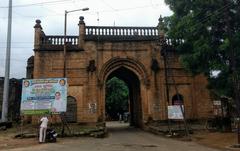Lalpeth Monoliths Consisting Of The Sixteen Colosal Stone Images.
Lalpeth Monoliths: Visiting Hours, Tickets, and Chandrapur Historical Sites Guide
Date: 14/06/2025
Introduction
The Lalpeth Monoliths, a stunning ensemble of sixteen colossal stone sculptures, stand as silent sentinels of Chandrapur’s rich historical, artistic, and spiritual legacy in Maharashtra, India. Dating from the 10th to 13th centuries CE, these monoliths are not just testaments to ancient craftsmanship but also windows into the pluralistic religious and cultural landscape of the medieval Deccan plateau. Their enduring presence offers visitors a unique opportunity to experience the intersection of history, art, and local traditions in one of Central India’s most intriguing heritage sites.
For official details, see:
Lalpeth Monoliths in Chandrapur: History, Visiting Hours, Tickets & Travel Guide
Wikimedia Commons
Chandrapur Online
Contents
- Historical Context
- Artistic and Iconographic Features
- Cultural and Religious Significance
- Visiting Information (Location, Hours, Tickets, Accessibility)
- Conservation Status
- Nearby Attractions
- Responsible Tourism Tips
- FAQs
- Conclusion
- Sources
Historical Context
Chandrapur, historically known as Chanda, has been a significant cultural hub since the 9th century CE. The Lalpeth Monoliths were carved between the 10th and 13th centuries, most likely under the patronage of regional rulers such as the Gond dynasty. These sculptures reflect the region’s complex tapestry of religious practices, incorporating Hindu, Jain, and tribal motifs. The monoliths probably formed part of a larger, now unfinished, temple complex, their incomplete state hinting at historical disruptions—political or economic—that halted their completion.
For more background, see:
Chandrapur Online
Artistic and Iconographic Features
Scale and Materials
Each monolith is carved from a single block of locally sourced basalt or granite, with heights ranging from 2 to 4 meters. Their robust forms and intricate details—ornamental headdresses, symbolic weapons, and stylized facial features—demonstrate exceptional stone-carving expertise.
Iconography
The monoliths embody a syncretic blend of Hindu deities and sacred symbols, reflecting the region’s pluralistic spirituality. Notable figures include representations of Shiva, Vishnu, the Goddess (Shakti), Hanuman, Ganesha, vahanas (divine vehicles), and rivers—each underscoring the multifaceted religious life of Chandrapur (Wikimedia Commons).
Artistic Techniques and Influences
The craftsmanship reveals expert use of iron tools and abrasives, with stylistic parallels to Deccan sites such as Ellora and Ajanta. Tool marks and unfinished sections offer rare insights into medieval sculpting methods.
Cultural and Religious Significance
The Lalpeth Monoliths continue to serve as sacred sites for local communities, integrated into festivals and rituals such as Ganesh Chaturthi and Navratri. The presence of diverse deities and natural symbols highlights Chandrapur’s tradition of religious inclusivity and its ongoing connection to ancient cultural practices (Tanushree Cabs; Facts.net).
Visiting Information
Location and Accessibility
- Address: Lalpeth area, Chandrapur district, Maharashtra, India
- Getting There: Accessible via Chandrapur city, which is well-connected by road and rail. The monoliths are 8–15 km from the city center. Local buses, taxis, and auto-rickshaws provide easy access.
Visiting Hours
- Open Daily: 8:00/9:00 AM to 6:00 PM (check with Chandrapur Tourism for updates)
Tickets and Entry Fees
- Entry: Free of charge; donations for maintenance are welcomed.
Facilities
- Restrooms and Water: Basic amenities are limited at the site; carry your own water and plan restroom breaks in Chandrapur city.
- Parking: Limited parking available near the site.
- Accessibility: Uneven terrain—mobility assistance is advisable for those who need it.
Guided Tours
- Guides: No official guides on-site, but local guides can be arranged in Chandrapur for in-depth context.
Best Time to Visit
- Recommended Months: October–February (cool and pleasant weather)
- Avoid: Hot summers (March–June), heavy monsoons (July–September)
Conservation Status
Despite their protected status under state heritage laws, the monoliths face threats from weathering, pollution, and unregulated visitor access. Conservation efforts, though increasing, remain limited by funding and resource constraints. Local authorities and organizations like the Chandrapur Forest Academy occasionally conduct maintenance, but comprehensive preservation plans are needed (Chandrapur Forest Academy; Res Militaris Conservation Article).
Nearby Attractions
Expand your Chandrapur itinerary with these sites:
- Tadoba Andhari Tiger Reserve: Renowned for wildlife safaris, ~40 km from Chandrapur.
- Mahakali Temple: Major Hindu shrine in the city.
- Bhadrawati Jain Temple: Testament to the region’s religious diversity.
- Buddhist Caves: Ancient rock-cut caves for history enthusiasts.
Responsible Tourism Tips
- Do Not Touch or Climb: Preserve the monoliths for future generations.
- Carry Away Litter: Leave no trace behind.
- Support Local Guides: Enhance your experience and contribute to the local economy.
- Respect Local Customs: Dress modestly; seek permission before photographing people.
Frequently Asked Questions (FAQs)
Q: What are the visiting hours for the Lalpeth Monoliths?
A: Open daily from 8:00/9:00 AM to 6:00 PM.
Q: Is there an entry fee?
A: No, but donations for conservation are appreciated.
Q: Are guided tours available?
A: Local guides can be hired in Chandrapur but are not stationed at the site.
Q: How do I reach the site?
A: The site is a short drive from Chandrapur city; taxis, buses, and auto-rickshaws are available.
Q: What facilities are available?
A: Basic; bring water and plan for limited amenities.
Q: Is the site accessible for people with disabilities?
A: The terrain is uneven—assistance is recommended.
Q: Can I take photographs?
A: Yes, but avoid flash and respect local restrictions.
Conclusion
The Lalpeth Monoliths are not only monumental remnants of Chandrapur’s ancient past but also living symbols of its ongoing cultural and religious vibrancy. Visitors are invited to experience this unique heritage site respectfully and thoughtfully, supporting conservation efforts and engaging with the local community. Each visit helps ensure these silent stone guardians continue to inspire and educate for generations to come.
For official updates, travel guides, and detailed resources, visit:
Chandrapur Tourism Official Site
Chandrapur Forest Academy
Wikimedia Commons
TravelSetu Guide
Res Militaris Conservation Article
Further Reading and Resources
- Lalpeth Monoliths in Chandrapur: History, Visiting Hours, Tickets & Travel Guide
- Wikimedia Commons: Lalpeth Monoliths
- History of Chandrapur
- Chandrapur Forest Academy
- Res Militaris Conservation Article
- TravelSetu Chandrapur Tourism
